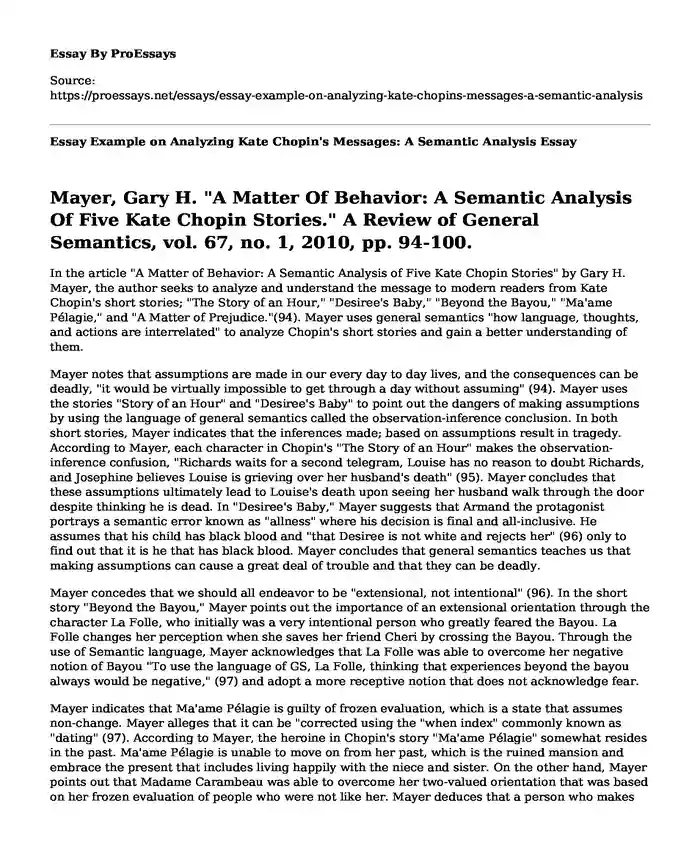Mayer, Gary H. "A Matter Of Behavior: A Semantic Analysis Of Five Kate Chopin Stories." A Review of General Semantics, vol. 67, no. 1, 2010, pp. 94-100.
In the article "A Matter of Behavior: A Semantic Analysis of Five Kate Chopin Stories" by Gary H. Mayer, the author seeks to analyze and understand the message to modern readers from Kate Chopin's short stories; "The Story of an Hour," "Desiree's Baby," "Beyond the Bayou," "Ma'ame Pélagie," and "A Matter of Prejudice."(94). Mayer uses general semantics "how language, thoughts, and actions are interrelated" to analyze Chopin's short stories and gain a better understanding of them.
Mayer notes that assumptions are made in our every day to day lives, and the consequences can be deadly, "it would be virtually impossible to get through a day without assuming" (94). Mayer uses the stories "Story of an Hour" and "Desiree's Baby" to point out the dangers of making assumptions by using the language of general semantics called the observation-inference conclusion. In both short stories, Mayer indicates that the inferences made; based on assumptions result in tragedy. According to Mayer, each character in Chopin's "The Story of an Hour" makes the observation-inference confusion, "Richards waits for a second telegram, Louise has no reason to doubt Richards, and Josephine believes Louise is grieving over her husband's death" (95). Mayer concludes that these assumptions ultimately lead to Louise's death upon seeing her husband walk through the door despite thinking he is dead. In "Desiree's Baby," Mayer suggests that Armand the protagonist portrays a semantic error known as "allness" where his decision is final and all-inclusive. He assumes that his child has black blood and "that Desiree is not white and rejects her" (96) only to find out that it is he that has black blood. Mayer concludes that general semantics teaches us that making assumptions can cause a great deal of trouble and that they can be deadly.
Mayer concedes that we should all endeavor to be "extensional, not intentional" (96). In the short story "Beyond the Bayou," Mayer points out the importance of an extensional orientation through the character La Folle, who initially was a very intentional person who greatly feared the Bayou. La Folle changes her perception when she saves her friend Cheri by crossing the Bayou. Through the use of Semantic language, Mayer acknowledges that La Folle was able to overcome her negative notion of Bayou "To use the language of GS, La Folle, thinking that experiences beyond the bayou always would be negative," (97) and adopt a more receptive notion that does not acknowledge fear.
Mayer indicates that Ma'ame Pélagie is guilty of frozen evaluation, which is a state that assumes non-change. Mayer alleges that it can be "corrected using the "when index" commonly known as "dating" (97). According to Mayer, the heroine in Chopin's story "Ma'ame Pélagie" somewhat resides in the past. Ma'ame Pélagie is unable to move on from her past, which is the ruined mansion and embrace the present that includes living happily with the niece and sister. On the other hand, Mayer points out that Madame Carambeau was able to overcome her two-valued orientation that was based on her frozen evaluation of people who were not like her. Mayer deduces that a person who makes such semantic errors is prone to "dividing the world into two forces without a middle ground" (99). Mayer also declares Madame guilty of a semantic error called indiscrimination as she tends to stereotype people based on her assumptions. Despite her errors, Mayer admits that Madame has risen from her prejudice and accept her grandchild and other people who are not like her "With the reconciliation complete, Madame says she no longer is prejudiced." She has been able to overcome her frozen evaluation.
Conclusion
Ultimately, using semantic analysis, Mayer shows how meaningfully Chopin communicated to modern readers. Mayer also doubts that semantic errors would ever be relinquished as they cause problems and tragedies in everyday life. According to Mayer, by being aware of these semantic errors and by concentrating on reducing them, we can have more logical and productive lives.
Work Cited
Mayer, Gary H. "A Matter Of Behavior: A Semantic Analysis Of Five Kate Chopin Stories." A Review of General Semantics, vol. 67, no. 1, 2010, pp. 94-100.
Cite this page
Essay Example on Analyzing Kate Chopin's Messages: A Semantic Analysis. (2023, Sep 11). Retrieved from https://proessays.net/essays/essay-example-on-analyzing-kate-chopins-messages-a-semantic-analysis
If you are the original author of this essay and no longer wish to have it published on the ProEssays website, please click below to request its removal:
- The Yellow Wallpaper Literary Response
- Analysis of Internal Conflict in "How It Feels to Be Colored Me" by Zora Neale Hurston
- Creative Writing on Alternate Ending of The Great Gatsby
- The Relevance of the Tempest in the Modern World Essay Example
- Essay Sample Joseph Strorm Character Analysis
- Essay Example on Cyborgia: Susan Slaviero's Whimsical Sci-Fi Poetry
- The Poet's Art: Assonance & Consonance - Essay Sample







